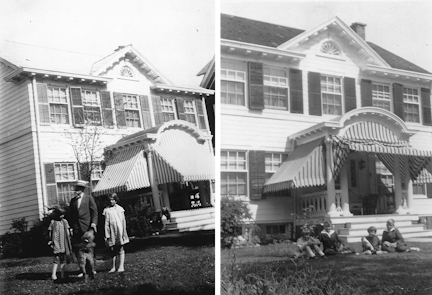
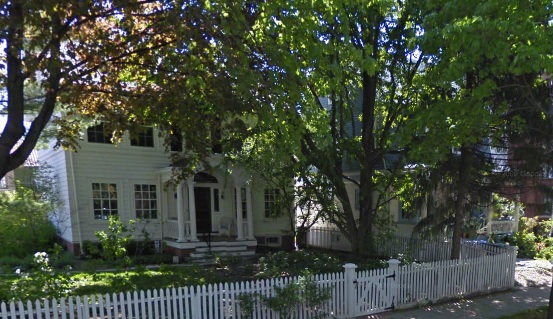
Quaint Marietta Avenue Home
A charming clapboard colonial-style home on Marietta Avenue stands out among its neighbors. The attractive white house at 3228 N. Marietta Ave. isn’t distinguished by large size but rather a relatively bigger setback from the street. It looks more like a country home than its neighbors. And it greets visitors with a cute white fence based on those of Nantucket, a favorite vacation spot of the owners.
At least two of the home’s owners have literary pedigree: One of its current owners is a longtime Milwaukee Journal Sentinel writer, and the prior owner, Nancy Ekholm Burkert, was an award-winning illustrator of children’s books. Burkert’s drawings in children’s books included a full-page illustration of the beloved Downer Avenue popcorn wagon.
A Milwaukee Journal article from the 1930s praised the Marietta home. The story quoted a Milwaukee architect who said of the home: “This is a house of real architecture.” The architect praised the proportion and detail of the home’s windows, the design of its porch and the attractive facades both in front and back.
In addition to this Marietta gem, Buemming and his firms designed many grand homes on the East Side and around the city and commercial buildings, such as the warehouse that today houses the Iron Horse Hotel.
Perhaps Buemming’s most notable design was for his own 1901 home at 1012 E. Pleasant St. The home, on the National Register of Historic Places, is “architecturally significant as a relatively pure example of a frame Classical Revival structure in pristine condition,” according to a city inventory of historic buildings.
– Jeff Bentoff

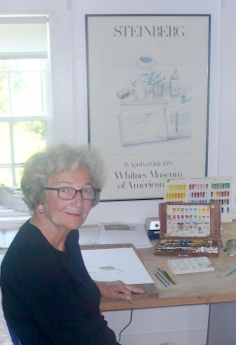
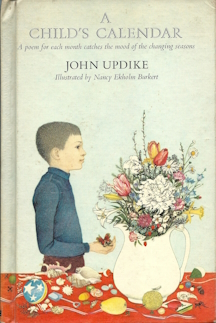
John Updike, an HWTN artist and the Downer Avenue popcorn wagon walked into a bar…
Actually, Pulitzer Prize-winning novelist John Updike, the historic Downer Avenue popcorn wagon and a Water Tower neighborhood artist didn’t walk into a bar.
But the three were connected in a different way — they all played roles in a well known 1965 children’s book, “A Child’s Calendar.”
The text of the book was written by Updike, who wrote “Rabbit, Run,” “The Witches of Eastwick” and many other acclaimed works. The original illustrator of the book was Nancy Ekholm Burkert, who lived for many years in a charming early 1900’s Georgian Revival clapboard home at 3228 N. Marietta Ave., here in the Historic Water Tower Neighborhood. And Burkert’s lovely drawing of the historic Downer Avenue popcorn wagon graced a page of “A Child’s Calendar.”
Burkert was also the original illustrator of “James and the Giant Peach” and won a Caldecott Honor in 1973 for “Snow-White and the Seven Dwarfs.”
In “A Child’s Calendar,” her drawing of the Downer popcorn wagon illustrates Updike’s poem about the month of May. Updike began the poem: “Now children may, go out of doors, without their coats, to candy stores.”
The historic popcorn wagon was a fixture on the corner of Downer Avenue E. Bellview Place from 1916 to 2007, when it was removed by a developer to make way for a new parking structure. According to a city history written before its removal:
“Milwaukee’s oldest popcorn wagon has reputedly stood at this site since 1916 and it might be one of the oldest, working popcorn wagons in America. Made of wood and metal, it is reminiscent of a small, nineteenth century peddler’s wagon. The interior still retains some of its original, steam-powered popcorn-making equipment although the apparatus is now powered by electricity. Research has not yet revealed just how old the wagon really is, but according to local folklore and the recollections of some East Side residents who have since passed away, the wagon has been standing there and in continuous use since about 1916. Originally the wagon was portable and could roll about, but many years ago it became a permanent part of the district when it was embedded into a poured concrete foundation….Several popcorn wagons of similar design dotted the city’s major thoroughfares before and after World War II but today all of the other historic wagons have vanished.”
In 2008, the Milwaukee Historic Preservation Commission issued a Certificate of Appropriateness for the new parking structure to be built on the site. Under the terms of the certificate, the developer was allowed to remove the historic wagon but was supposed to preserve it and return it to the Downer area. Despite the requirement, the wagon’s current whereabouts and condition are uncertain.
The last article we’ve seen on the wagon’s fate suggested at the time that it might be for sale.
When we wrote about the wagon on our Facebook page in a February 2013 photo quiz, several contributed their memories and impressions:
- “As Joni Mitchell once sang – They have paved paradise and put up a parking lot.”
- “I think of Mrs. M’s –– and the popcorn with coconut oil, the candy wristwatches, among other delights –– every time I wait on that corner for the light to change.”
- “A great loss.”
- “Sigh.”
- “At least in the mid to late 90s when I ran that popcorn wagon with a friend, there were no remains of steam powered popcorn making equipment.”
- “Where is it now?”
- “Little candies on white paper strips across from the Downer theater!!”
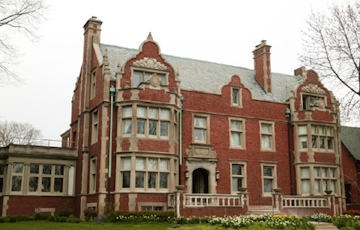

Alexander C. Eschweiler
Alexander C. Eschweiler, the architect of many landmark historic Milwaukee buildings, also designed several notable mansions in and around the Historic Water Tower Neighborhood — including homes for himself and his mother.
The list of Milwaukee buildings designed by Eschweiler or the firm he founded includes downtown’s Wisconsin Gas Building with its famed weather flame, the Wisconsin Telephone Building on N. Broadway, the Milwaukee Arena and the John Mariner Building (now Hotel Metro).
Eschweiler also designed four 1911-1912 buildings on the Milwaukee County Grounds constructed originally for the Milwaukee County School of Agriculture and Domestic Economy. They are now threatened with potential demolition, and preservationists are working to save the buildings.
Work by Eschweiler in the HWTN includes the Robert Nunnemacher Residence, 2409 North Wahl Ave.; Edward G. Cowdery House (also known as the Albert C. Elser House), 2743 North Lake Dr.; John Murphy House, 2030 E. Lafayette Pl.; Victor L. Brown House, 2690 N. Lake Dr.; Frank Ward Smith House, 2405 E. Wyoming Pl.; Hayes-Friend House, 2651 N. Summit Ave.; Alexander Chadbourne Eschweiler House, 2810 E. Bradford Ave. (his own home); and Hannah Lincoln Chadbourne Eschweiler House, 2825 N. Hackett Ave. (which he designed for his widowed mother).
Former Milwaukee Journal Sentinel writer Whitney Gould, in a story discussing Eschweiler’s life, career and impact on Milwaukee, said that his “work for Milwaukee’s movers and shakers a century ago left a lasting imprint on east side neighborhoods and shaped our civic identity. So powerful was his influence that even today, ‘living in an Eschweiler’ is almost akin to owning a Rembrandt.”
According to his Wikipedia profile, Eschweiler was born in Boston and opened his practice in Milwaukee in 1892. In 1923, sons Alexander C. Eschweiler Jr., Theodore and Carl joined him at the firm, which was renamed Eschweiler & Eschweiler. The senior Eschweiler died in 1940.
Buildings he or his firm designed just outside the HWTN boundaries include the Charles Allis House, 1801 N. Prospect Avenue (now the Charles Allis Art Museum), the Elizabeth Black Residence, 1537 N. Prospect Ave.; and on the current University of Wisconsin-Milwaukee campus, the Thomas A. Greene Memorial Museum and the Milwaukee-Downer “Quad” on the NW corner of Hartford and Downer Aves.
Thomas Eschweiler, a grandson of the elder Alexander Eschweiler, and Thomas’ wife Gabrielle, were longtime members of HWTN. They lived in a 1925 home at 2659 N. Terrace Ave. that was designed by Thomas’ father, Alexander C. Eschweiler Jr. Like his father and grandfather, Thomas also was an architect, and he joined the family firm, later working as director of construction for Milwaukee Public Schools and founding the Wisconsin Architectural Archives. After his death at age 90 in 2012, his memorial service was held at the Charles Allis Art Museum, which his grandfather designed.
Many Eschweiler buildings are listed on the National Register of Historic Places and are part of Milwaukee preservation districts.
– Jeff Bentoff
Historic Water Tower Neighborhood Preservation
Guidelines and Resources to Help Maintain Your Historic Home
The Story of Your Historic Home
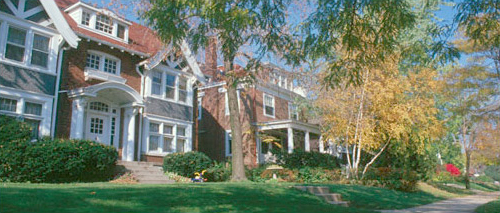
Researching Your Home’s History
Want to learn more about the history of your historic home? Here
are valuable resources:
- “Researching Your Home at Milwaukee Public Library’s Central Library” (MPL flyer PDF)
- Researching the history of your Milwaukee home (Milwaukee Historic Preservation Commission website)
- “Find your thread in the tapestry of Milwaukee history” (OnMilwaukee.com article on researching your home’s history)
- Books and other resources listed on our Neighborhood History page include information on many specific homes in our area.
HWTN Calendar
Historic Water Tower Neighborhood has events throughout the year to keep members updated on local issues, current on neighborhood events, and active with social opportunities for members to enjoy! Members should watch for HWTN emails for complete details as we get closer to the event date.
2025 HWTN Parties
Click on the date for more information - link will become active once details & RSVP for event become live:
June 14th Home & Garden Party hosted by Dan and Larry on Wyoming Place
July 12th Home & Garden Party hosted by Chris and Jennifer on Lake Drive
August 16th Home & Garden Party hosted by Doug and Jola on Wyoming Place
September TBD Home & Garden Party
October 31st Halloween Party hosted by Tom and Suzanne on Terrace Ave
December 13th Holiday Party hosted by Andy on Kenwood Ave

